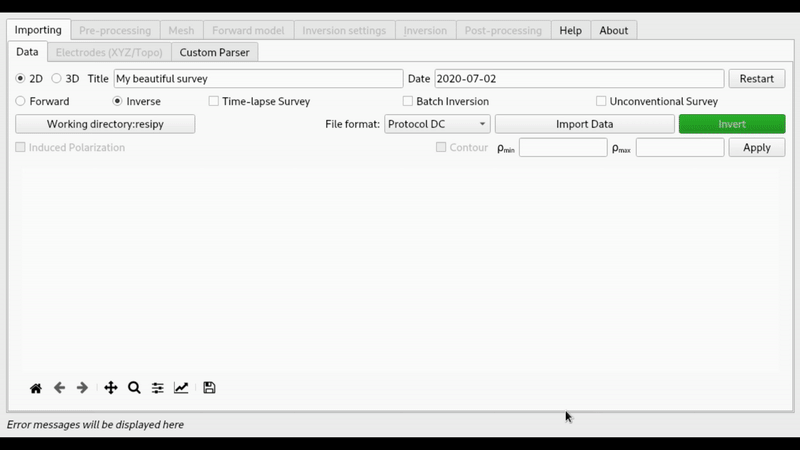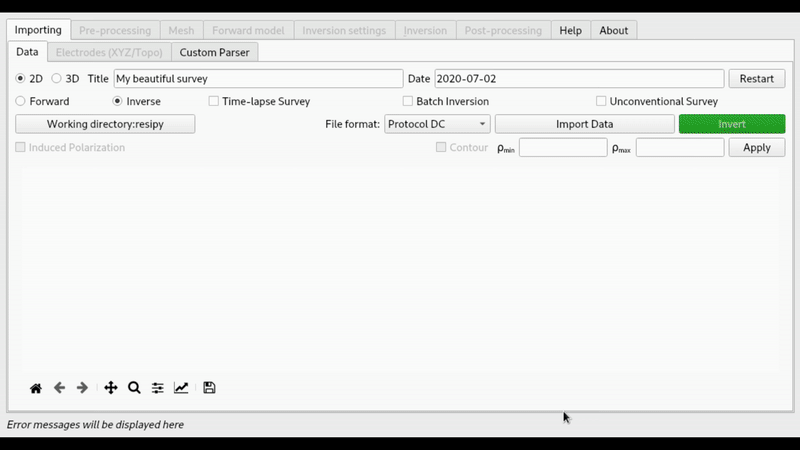ResIPy
ResIPy is a Python wrapper around the R* family of codes (for 2D/3D DC/IP inversion). ResIPy provides a standalone graphical user interface (GUI) along with a Python API (Application Programming Interface) for use in Jupyter notebook. Have a look at the Gallery of examples or subscribe to our YouTube channel (ResIPy) to learn more.
ResIPy aims to be:
Simple and intuitive to use (you can invert your data in one-click with all default settings)
But still allowing the user to have full control on data filtering, error modelling, mesh parameters and inversion settings
What it can do


The same processing can be achieved with the API reference:
from resipy import Project
k = Project(typ='R2')
k.createSurvey('examples/dc-2d/syscal.csv')
k.showPseudo() # show pseudo-section
k.invert() # invert measurements
k.showResults() # display inverted section
More examples are available in the Gallery of examples.
Download
Important
The easiest way is to download one of the standalone executables (.exe or .zip) from GitLab.
If you wish to modify the code or just get the latest version, you can also run from source like this:
git clone https://gitlab.com/hkex/resipy cd resipy/src python ui.py
Alternatively you can install the API part of the module (so no GUI) from pypi using pip:
pip install resipy
Mac and Linux user will need wine to run the inversions. For more details please refer to the GitLab.
Project structure

General overlook of the project structure with the three main parts. Please refer to the GitLab if you want to contribute.
Contents
- Graphical User Interface
- GUI in animated GIF
- Gallery of examples
- R2 basic tutorial
- Inversion with topography
- Time-lapse inversion
- Batch inversion
- Cross-Borehole example
- Forward modelling
- 3D viewing
- Time-lapse 3D survey
- Vizualisation of infiltration into a sand column
- Create a 3D survey from 2D lines
- Create a a pseudo 3D survey from 2D lines
- Global sensitivity analysis
- API reference
ProjectR2cdcudaRm()getSysStat()parallelRm()systemCheck()SurveyfixSequence()polyfit()Meshcheck4repeatNodes()cylinderMesh()dat_import()halfspaceControlPoints()in_box()mergeMeshes()moveMesh2D()points2vtk()prismMesh()quadMesh()readMesh()runGmsh()tankMesh()tetgen_import()tetraMesh()triMesh()voxelMesh()vtk_import()vtk_import_fmt4()
Indices and tables
Citing ResIPy
If you use ResIPy for you work, please cite this paper as:
Blanchy G., Saneiyan S., Boyd J., McLachlan P. and Binley A. 2020. “ResIPy, an Intuitive Open Source Software for Complex Geoelectrical Inversion/Modeling.” Computers & Geosciences, February, 104423. https://doi.org/10.1016/j.cageo.2020.104423.
BibTex code:
@article{blanchy_resipy_2020,
title = {{ResIPy}, an intuitive open source software for complex geoelectrical inversion/modeling},
issn = {0098-3004},
url = {http://www.sciencedirect.com/science/article/pii/S0098300419308192},
doi = {10.1016/j.cageo.2020.104423},
pages = {104423},
journaltitle = {Computers \& Geosciences},
author = {Blanchy, Guillaume and Saneiyan, Sina and Boyd, James and {McLachlan}, Paul and Binley, Andrew},
urldate = {2020-02-07},
date = {2020-02-04},
langid = {english}
}